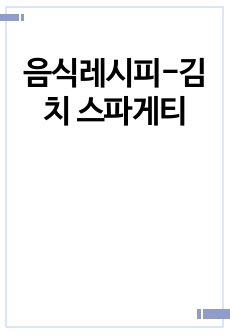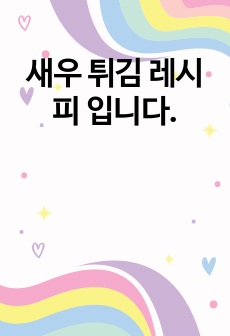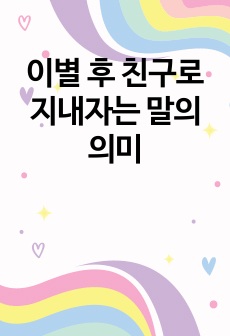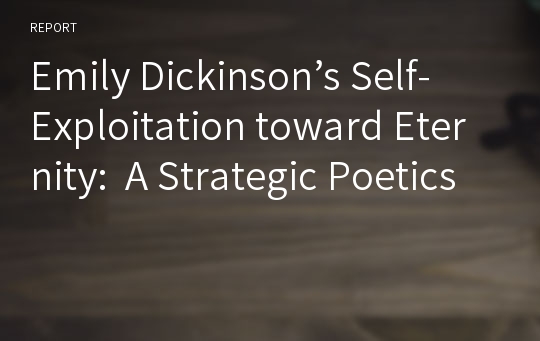Emily Dickinson’s Self-Exploitation toward Eternity: A Strategic Poetics
*종*
다운로드
장바구니
소개글
In the study of Emily Dickinson and her poetry, her life itself has been the main subject of many critical surveys. The importance of biography seems to be overestimated in the case of Emily Dickinson even ignoring the true understanding of her poetry. It is certain that her life of quest is indeed a unique one and this quality stimulates our curiosity. In that respect, Henry Wells likens very pertinently her life and poetry to “leaf and flower.” Emily Dickinson was born in 1830 and died in 1886 in Amherst, Massachusetts leaving about 1775 poems unpublished except seven. Unfortunately, most of professional critics and students have suffered from her original creativity in the content and form of her poetry (the unconventional uses of quantity, rhymes, punctuation, imagery, and language, etc.). An obvious fact that Emily Dickinson is still alive in our time is demanding more diverse and also intensive approaches and efforts to interpret her poetry.목차
없음본문내용
The vision of Emily Dickinson’s poetry is focused on the identification of man’s relation with reality mainly in the pursuit of the meaning of death. The unique quality of her poetic vision is constituted through what I call self-exploitation, which is completed by the strategies of self-denial, “microscopic” perspective, “smallness” and cyclic vision. I will identify what Emily Dickinson’s self-exploitation is by explaining her poetic strategies presented and concretized in poems, and, in each case, I will discuss why she uses these strategies to gain a vision of eternity and the meaning of death as the key to man’s relation with reality.The poetic experience of Emily Dickinson’s self-exploitation in the quest for reality is done primarily in nature. Nature is really an experimental place for her poetry. William insists that Emily Dickinson “cherishes a fairy-like intimacy with plant and bird,” and that “no naturalist, still she knew them all and believed that these mute creatures expressed thoughts surpassing her own.” It conveys cautiously that the poet is searching for the truth or eternity through nature.
This is my letter to the World
That never wrote to Me—
The simple News that Nature
told—
With tender Majesty (J. 441)
The poet says her “letter”—poetry—is the message she heard from nature. In fact, she is using nature as a mediator for achieving her vision of reality. That is, Emily Dickinson tries to catch the universality of man by scrutinizing or becoming the particularity in nature such as birds, insects, fly, flower, sun, grass, trees, seasons and so on.
참고 자료
Anderson, Charles R. Emily Dickinson’s Poetry: Stairway of Surprise.New York: Holt, Rinehart and Winston, 1963.
Carey, Hilda. “The Lure of Circumference: A Study of the meaning of
the term ”Circumference” in the writing of Emily Dickinson.” 『성심
여대논문집』 8 (1977): 53-94.
Davis, Thomas M. 14 by Emily Dickinson: With Selected Criticism.
Chicago, N. J.: Scott Foresman and Co., 1964.
Eberwein, Jane Donahue. Dickinson: Strategies of Limitation. Amherst: The Univ. of Massachusetts P, 1985.
Ferlazzo, Paul J. Critical Essays on Emily Dickinson. Boston, G. K. Hall
and Co., 1984.
Kazin, Alfred. An American Procession: The Major American Writers
from 1830-1930─The Crucial Century. New York: Vintage Books,
A Division of Random House, 1985.
Park, O-Bok. “The Tragic Dialectic in Emily Dickinson’s Poetry.” Ph.
D. dissertation, Sogang University, 1987.
Porter, Davis T. The Art of Emily Dickinson’s Early Poetry. Cambridge,
Mass.: Harvard UP, 1966.
Sewell, Richard B., Ed. Emily Dickinson: A Collection of Critical
Essays. Englewood Cliffs, N. J.: Prentice-Hall, Inc., 1963.
Thackrey, Donald E. “The Circumference of the Word.” In Emily
Dickinson: A Collection of Critical Essays. Ed. Richard B. Sewell.
N. J.: Prentice-Hall, Inc., 1963.
Wells, Henry W. Introduction to Emily Dickinson. New York:
Hendricks House, Inc., 1959.
Wilhelm, Albert. “Emily Dickinson: Rebel of Amherst.” 『영어영문학』
30 (1984): 347-58.
Williams, Stanley T. “Experiment in Poetry: Emily Dickinson.” In The
Recognition of Emily Dickinson: Selected Criticism Since 1890. Ed.
Caesar R. Blake and Carlton F. Wells. Ann Arbor: The Univ. of
Michigan P, 1965.



























